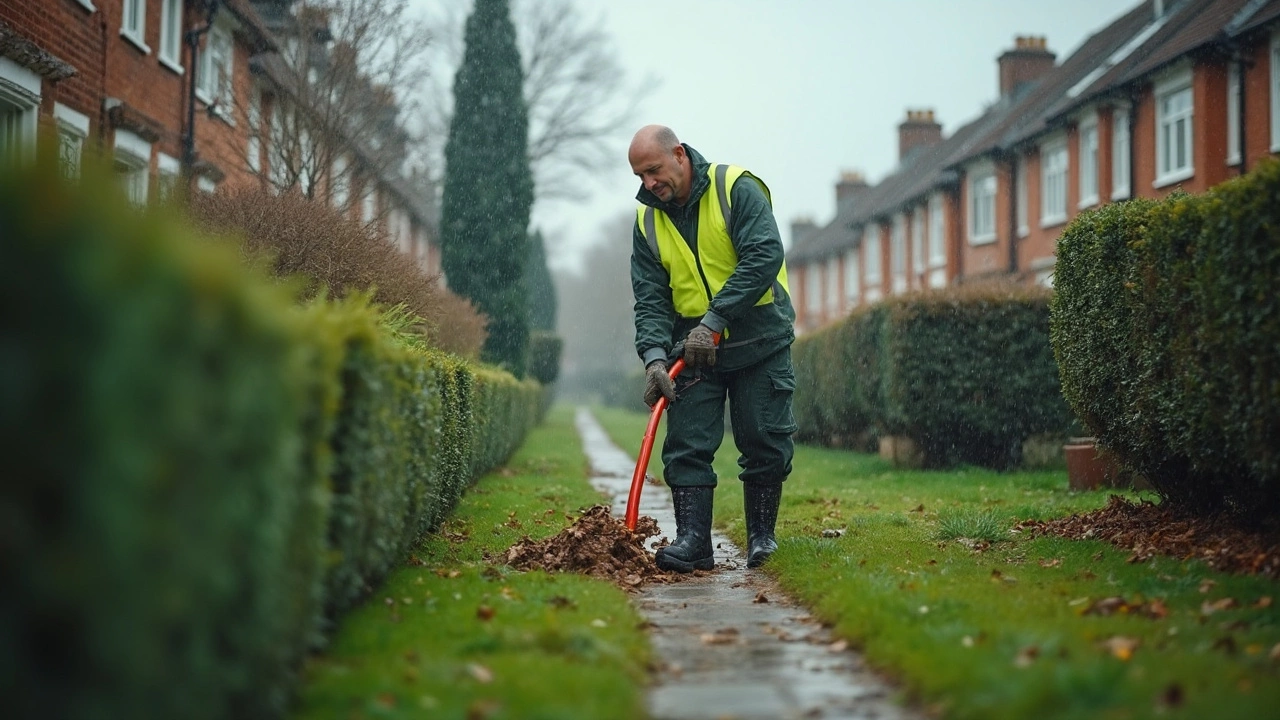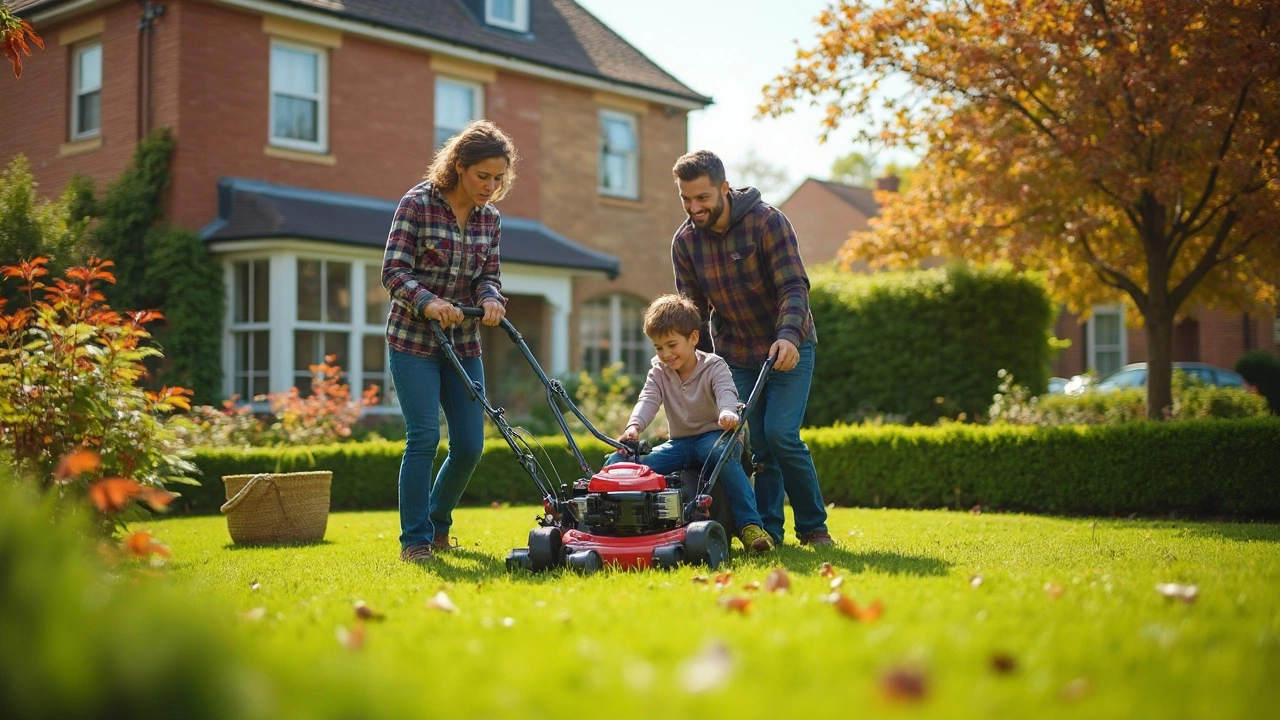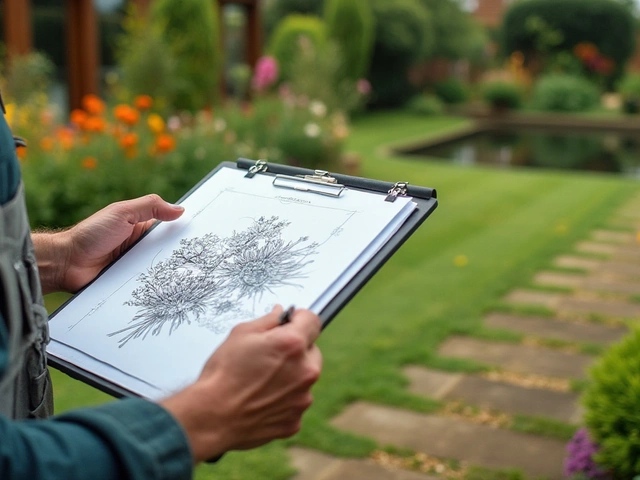Ever look out your window and wonder what exactly counts as yard work? It's not just mowing the grass every weekend—that's only a piece of the puzzle. Yard work covers all the stuff that keeps your outdoor space looking alive instead of abandoned. We're talking mowing, trimming, picking up sticks, clearing out old leaves, even pruning those shrubs that keep poking you when you fetch the mail.
It's easy to think of it as just cutting grass, but if you skip the other parts, things get wild fast. Ever left leaves on the lawn too long? Suddenly, you've got brown patches and weird bugs moving in. Ignoring those edges means your driveway and sidewalk start looking overgrown and sloppy. Basically—yard work isn't just for show; it's about giving your space a little regular care so it doesn’t turn into a jungle or a mud pit.
- The Essentials: What Counts as Yard Work?
- Going Beyond: Extras Pros Often Tackle
- Why Regular Yard Work Actually Pays Off
- DIY or Hire Out? What Makes the Most Sense
- Quick Tips to Make Yard Work Easier
The Essentials: What Counts as Yard Work?
Yard work covers way more than just hauling out the mower and giving the grass a buzz. There are lots of moving parts, and when you piece them together, they keep everything looking neat, healthy, and safe. Here’s what’s actually involved when someone talks about doing yard work:
- Lawn mowing: The bread and butter of yard work. Keeping your grass at the right height is key—not only for looks, but to avoid weeds and pests. Most folks mow every 1-2 weeks in the growing season.
- Edging and trimming: After mowing, those little shaggy spots along sidewalks and flower beds need a trim. Edgers and string trimmers help finish the job and make things look sharp.
- Weeding: Left unchecked, weeds steal sun and nutrients from your plants and lawn. Good yard work always includes pulling or treating weeds, especially in garden beds and cracks.
- Leaf and debris cleanup: Fallen branches, leaves, and random junk need to be cleared out. Letting this stuff pile up can suffocate grass, mess with drainage, and bring in bugs.
- Watering and fertilizing: Your grass needs both. Consistent watering (early morning is best) and applying fertilizer a few times a year can boost color and growth.
- Pruning shrubs and bushes: Overgrown plants look messy and can block light and air. Clipping them back a couple times a year keeps everything healthier.
Check out this quick breakdown of how often people tackle these basic tasks:
| Yard Task | How Often |
|---|---|
| Mowing | Every 1–2 weeks in growing season |
| Edging/Trimming | Every 2–4 weeks |
| Weeding | Weekly to monthly |
| Leaf Cleanup | As needed, especially in fall |
| Watering | 2–3 times per week during dry spells |
| Fertilizing | 2–5 times per year |
| Pruning | 1–2 times per year |
Sticking to these basics helps avoid yard disasters—patchy lawns, bug problems, clogged gutters, and runaway plants. Knock out these core pieces, and your yard will never embarrass you when friends or neighbors drop by.
Going Beyond: Extras Pros Often Tackle
If you hire a landscaping service, they usually go way past just mowing the lawn. Pros see details most people miss—and they’ve got the gear and know-how to tackle the jobs most homeowners skip. Sure, you get a tidy yard, but you also get stuff like mulching, fertilizing, and pest control. All those things boost your yard’s health, not just its looks.
One big thing is lawn aeration—they poke small holes in your lawn, which helps air, water, and nutrients reach the grass roots. This makes a real difference for those patchy spots people complain about. Many services also check for soil problems and offer special treatments, like dethatching, to clear out old dead grass that chokes your yard.
Here’s what you’ll often find on a pro’s extra-services menu:
- Mulching garden beds to save water and stop weeds
- Fertilizing (with the right mix for your region and season)
- Aerating and dethatching lawns
- Trimming hedges so they don’t eat your fence
- Planting seasonal flowers or new shrubs
- Pest and weed control to keep your yard in check
- Cleaning out gutters and drains
Actually, a lot of folks don’t realize pros also do stuff like installing hardscape features (think patios, walkways, edging), and even putting in basic outdoor lighting for safety and looks. Bigger jobs like tree removal or stump grinding are also on offer—stuff most people would never try at home.
To give you a snapshot, here’s a quick table showing how often these extras usually get done:
| Service | Recommended Frequency |
|---|---|
| Mulching | 1-2 times per year |
| Aeration | Once per year (spring or fall) |
| Fertilizing | 2-4 times per year |
| Trimming Hedging | Every 2-3 months |
| Pest/Weed Control | As needed, often monthly |
If you want your yard work to last, these extras make all the difference. They’re why pro landscaping services often leave your place looking next-level compared to a basic mow-and-go job.

Why Regular Yard Work Actually Pays Off
Let’s be honest, nobody wants to spend their weekend pulling weeds or raking leaves for fun. But skipping yard work isn’t just about having a yard that looks wild. Regular attention actually saves you a lot of hassle and money in the long run. And there’s proof to back this up.
For starters, a tidy yard boosts curb appeal big time. According to recent surveys, homes with well-kept yards sell for an average of 7% more than similar properties with overgrown or messy lawns. Want to move someday? That could mean thousands in your pocket.
But there’s more going on here. Keeping up with the basic yard work stops problems before they start. When you mow, you prevent weeds from going to seed. That means less fighting weeds next season. Trimming shrubs lets air and sunlight reach your plants, making your garden healthier and less likely to get diseases or attract pests like ticks and mosquitoes.
Let’s talk safety and comfort. Neglected yards can hide trip hazards and attract critters. Want less mud and fewer mosquitoes after a rainstorm? Keep leaves and debris clear, especially from walkways and drains.
Check out these stats for some quick comparisons:
| Task | What It Prevents | Money Saved Annually (Avg.) |
|---|---|---|
| Mowing Weekly | Weed spread, lawn disease | $200 (on repairs & costly treatments) |
| Leaf Removal | Mold, pest nesting, slip hazards | $150 (medical/repair costs) |
| Shrub/Tree Pruning | Pest infestations, property damage | $300 (tree/siding repairs) |
Bottom line: keeping up with regular yard work means less stress, more savings, and an outdoor space you actually want to enjoy. You don’t have to go full-on perfectionist, but a steady routine really does pay off.
DIY or Hire Out? What Makes the Most Sense
Trying to decide if you should tackle yard work yourself or call in the pros? That question pops up almost every spring, and honestly, there’s not one right answer for everyone. Here’s how it usually breaks down.
If you’re into getting some fresh air, want to save a few bucks, and have a small yard, doing it yourself can be pretty rewarding. But it’s not always a walk in the park. You’ll need time—American homeowners spend about 60 hours a year just on basic yard work. Add in the gear costs (a solid mower, trimmer, blower, and basics like gloves), and those Saturday mornings are gone for good. For some folks, it’s totally worth it. My dog Rocky loves the extra backyard time out there—bonus points if your pet enjoys the mess with you.
But let’s be real. Larger yards, busy schedules, or just not wanting to deal with allergies and heat strokes? Then hiring a landscaping service starts sounding great. Plus, the pros know their stuff. They’ll spot problems—like weird fungus or bugs—before you’ll even notice. And with commercial equipment, they get the job done faster and often better. If you worry about curb appeal or plan to sell soon, a pro can make things pop. Studies show tidy landscaping can boost property value by up to 15%.
Bills do add up though, so here’s a quick snapshot that can help you compare:
| DIY Yard Work | Hiring Out |
|---|---|
| Average Spending: $150-400/year (tools + supplies) | Average Spending: $900-2600/year (full service) |
| Time: ~60 hrs/year | Time: ~2-3 hrs coordinating/year |
| Learning by trial and error | Expert knowledge, less stress |
| Flexibility (do it when you want) | Scheduled service (set days/times) |
Here’s another way to think about it:
- DIY makes sense for small yards, light jobs, and if you actually enjoy working outside.
- Hire out if you value your time, have a large space, or want things handled by professionals who know landscaping inside and out.
- If you like both, some folks mix it—maybe mow yourself, but let the pros handle leaf cleanup or tricky stuff like tree pruning.
No matter which route you go, just remember: skipping yard work adds up fast. Make staying on top of it part of your routine and your outdoor space will stay inviting without the stress.

Quick Tips to Make Yard Work Easier
If you want yard work to feel less like a chore, it helps to work smarter. A few practical tweaks can cut your time in half and might even keep your back from giving out. I learned most of these after a summer when my dog, Rocky, practically disappeared in the weeds because I let things go too long. Don’t be like me—set yourself up for easy wins.
- Yard work goes faster with the right tools. Use a mulching mower to save time on bagging clippings, or a string trimmer for tight corners.
- Set a weekly routine. If you knock out small tasks more often, you avoid the huge mess that builds up in just two or three weeks. Most experts agree that mowing once a week during peak growing season keeps lawns looking sharp.
- Sharpen mower blades at least once each season. Dull blades tear up the grass instead of cutting, leaving your lawn with brown tips.
- Work early in the day. You’ll beat the heat and dodge biting bugs that come out at dusk.
- For weeds, pull them after rain or watering; the ground is soft, so roots come out cleaner.
- Use yard waste bags or a compost bin to keep debris contained and cut down on cleanup time.
- Switch to ergonomic tools. Handles with soft grips and lighter rakes can save your hands and back on longer jobs.
- Break up big jobs—aim for one project per day instead of killing your weekend.
Here’s a quick look at how using some of these strategies makes a difference:
| Yard Task | Without Tips | With Tips |
|---|---|---|
| Mowing (1/4 acre) | 90 minutes (bagging clippings) | 55 minutes (mulching mower, maintained blades) |
| Leaf Cleanup | 2-3 hours (once/month) | 45 minutes (weekly, ergonomic rake, use of bags) |
| Weeding | 60 minutes (dry soil, no tools) | 30 minutes (post-watering, hand tool) |
Paying attention to small things really adds up. Even just putting your yard tools back where they belong keeps you from digging through the garage every time you need them. And if you’re overwhelmed, don’t feel bad about calling in the pros for the big stuff—sometimes, that’s the real time-saver.








